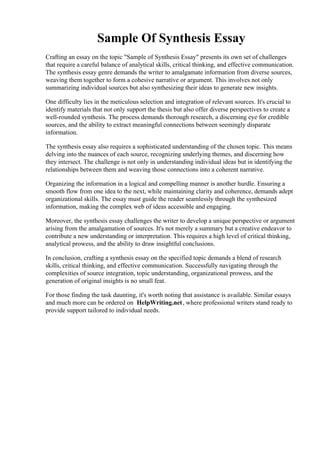Synthesis writing, an advanced academic skill, requires the ability to analyze and synthesize information from multiple sources to form a cohesive and original essay. This comprehensive guide provides a step-by-step approach, practical tips, and compelling examples to empower you in mastering synthesis writing.

Understanding Synthesis Writing
Synthesis writing involves combining ideas, theories, and evidence from various sources to create a new perspective or argument. It differs from summary writing, which simply restates information. Instead, synthesis writing requires students to engage in critical thinking, analysis, and evaluation to draw insightful conclusions.
Key Features of Synthesis Writing:
- Blends information from multiple sources
- Presents a new perspective or interpretation
- Supports arguments with evidence from credible sources
- Demonstrates critical thinking and analysis skills
Steps to Craft a Stellar Synthesis Essay
1. Read and Analyze Source Materials
- Read attentively: Engage actively with the assigned sources, highlighting key points and evidence.
- Identify main ideas and arguments: Determine the central themes and positions presented in each source.
- Analyze connections: Explore how the sources relate to each other, identifying similarities, differences, and areas of overlap.
2. Develop a Thesis Statement
- Formulate a concise thesis: Write a statement that articulates your central argument or position based on the synthesized information.
- Ensure clarity and focus: Your thesis should be specific, arguable, and supported by evidence from the sources.
3. Organize and Outline
- Create an outline: Organize your essay into logical sections, ensuring a smooth flow of ideas.
- Transition smoothly: Use transition words and phrases to connect paragraphs, showing the relationships between ideas.
- Consider a counterargument: Acknowledge and address opposing viewpoints to strengthen your argument.
4. Draft the Essay
- Paragraph Structure: Each paragraph should focus on a specific topic or argument, supported by evidence from the sources.
- Integrate Sources: Cite and paraphrase information from the sources, avoiding plagiarism.
- Use QUOTATIONS SPARINGLY: Only include direct quotes when necessary to provide specific evidence or impact.
5. Revise and Edit
- Review the Thesis: Ensure that your thesis statement is supported throughout the essay.
- Check for Consistency: Verify that the essay flows logically and that evidence is presented accurately and consistently.
- Edit for Clarity: Revise sentence structure, grammar, and punctuation to enhance readability.
Tips for Effective Synthesis Writing
- Read diverse sources: Seek out multiple perspectives to gain a comprehensive understanding of the topic.
- Take notes: Write down key points, direct quotes, and your own thoughts as you read.
- Paraphrase and Summarize: Express source ideas in your own words to avoid plagiarism.
- Use Signal Words: Incorporate words like “according to,” “suggests,” and “in contrast” to indicate the source of information.
- Avoid Plagiarism: Cite all sources accurately using the appropriate citation style.
Example of a Synthesis Essay
Topic: The Impact of Social Media on Mental Health
Thesis Statement: While social media can provide benefits, it also poses potential risks to mental well-being, particularly among young adults.
Paragraph 1:
* Discusses the positive aspects of social media, such as connecting with others and accessing support.
* Cites a study showing that moderate use can enhance social connections and well-being.
Paragraph 2:
* Explores the negative consequences, including increased anxiety, depression, and cyberbullying.
* Presents evidence from a survey revealing that excessive social media use is associated with mental health issues.
Paragraph 3:
* Analyzes the role of age, as younger individuals may be more vulnerable to the adverse effects of social media.
* Highlights a study indicating that teens who spend more time on social media have a higher risk of depression and low self-esteem.
Paragraph 4:
* Discusses potential solutions, such as promoting healthy usage habits and providing mental health resources.
* Cites a report recommending that parents and educators should guide young people in using social media responsibly.
Tables to Enhance Synthesis Writing
| Table 1: Quantitative Data on Social Media and Mental Health |
|—|—|
| | Positive Impacts | Negative Impacts |
| Study 1 | Increased social connections, well-being | Increased anxiety, depression |
| Study 2 | Enhanced communication skills | Cyberbullying, social comparison |
| Study 3 | Reduced loneliness | Negative body image, sleep disturbances |
| Table 2: Qualitative Perspectives on Social Media Use |
|—|—|
| | Positive Experiences | Negative Experiences |
| User 1 | “Social media helps me stay connected with friends and family.” | “I feel pressured to present a perfect image online.” |
| User 2 | “I find support and information from online communities.” | “I’ve been exposed to cyberbullying and online harassment.” |
| User 3 | “Social media inspires me to pursue my passions.” | “I spend too much time on social media and neglect other aspects of my life.” |
Conclusion
Synthesis writing empowers students to engage with a range of ideas, develop critical thinking skills, and produce insightful essays. By following the steps, tips, and examples outlined in this comprehensive guide, you can enhance your ability to synthesize information and craft cohesive and compelling written works. Remember, synthesis writing is an iterative process that requires practice and refinement. With dedication, you can master this valuable skill and excel in academic and professional writing.
